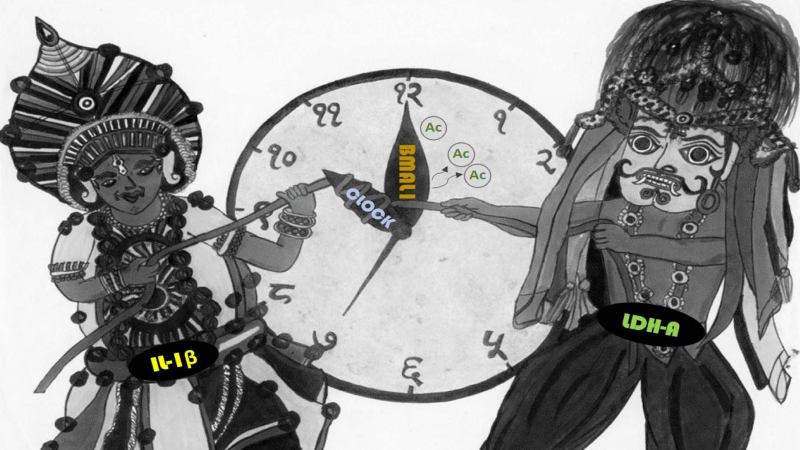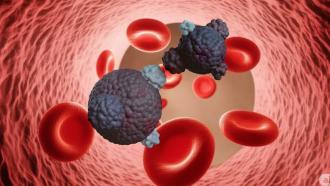
An artistic representation of the L-I-C network in cancer cells depicted in the Indian art form, Yakshagana and Somana Kunitha style (Credit Kirti Lathoria)
Our body functions tune to the circadian rhythm — the 24- hour day-night cycle. A biological clock comprising special cell components and genes keep track of time and operate synchronously in a complex molecular mechanism. The timekeeping molecules control several crucial physiological processes like metabolism, cell division and proliferation, immune response, and gene expression (decoding genetic information to produce proteins) to maintain the delicate balance of the rhythm. However, science has shown that when the circadian rhythm is severely hampered, some cells break away from the clock control and turn cancerous.
Existing literature shows that cancer cells have an erratic circadian rhythm and abnormal metabolism. Besides, they sustain the onslaught of ‘cytokines’ from the immune system. However, how exactly these processes promote cancer cell growth has remained elusive.
A team of researchers from the National Brain Research Centre, Manesar, has decoded the interplay between cancer cell metabolism, pro-inflammatory cytokines (inflammation-causing immune molecules), and the biological clock molecules. Their study shows that the cancer cells chemically rewire the production of an inflammation-inducing mediator IL-1β and lactate - a by-product of cancer cell metabolism. Furthermore, these two components chemically manipulate the clock machinery to trigger further production of lactate and IL-1β. Thus the three components work in tandem to promote a vicious loop of tumour growth. The team has published their results in the journal Molecular and Cellular Biology.
The results of this research will provide a framework for cancer chronotherapy – a novel treatment method by which anticancer drugs are administered at optimal timings to enhance their chemotherapeutic potential.
The team conducted laboratory experiments on cultured brain cancer cells by employing several molecular testing methods to observe the function of the cell processes.
Cancer cells hoodwink the circadian checkpoints and alter their metabolism to feed the rapidly growing cells. “The common feature of cancer cell metabolic reprogramming is glucose addiction –– a heightened glucose uptake as compared to a normal cell,” says Dr Ellora Sen, Principal Investigator of the study. Unlike healthy cells, cancer cells metabolise glucose even in the presence of oxygen. This ‘aerobic glycolysis’ produces large amounts of lactate, resulting in a highly acidic environment around the tumour – a hallmark feature of cancer. Also, the high acidic environment triggers some genes which help tumour growth.
When there is a disease or injury, the immune system dispatches pro-inflammatory cytokines to induce a mild inflammation at the injury site. The inflammation destroys the diseased cells and facilitates healing. IL-1β is once such cytokine released in response to cancerous growths. “Our findings indicate that high lactate levels trigger expression of IL-1β,” says Dr Sen.
The rapidly multiplying cancer cells activate the immune system to send a surge of IL-1β cytokines. “In our earlier study, we found that the cancer cells use IL-1β to enhance the expression of another protein called Hexokinase (HK2), which increases the glucose uptake,” adds Pruthvi Gowda, first author of the study. With HK2 promoting glucose intake, the cancer cells get more fuel to multiply.
The team then found that high lactate and IL-1β also increased two crucial circadian molecules, Clock and Bmal1. Bmal1 regulates cell division and is bound to the Clock molecule in what is chemically called a transcriptional dimer. In healthy cells, Clock and Bmal1 work in a complementary manner to control cell growth. However, the researchers noticed that both lactate and IL-1β chemically modify Bmal1 to increase the Clock -Bmal1 binding stability.
“Further molecular experiments revealed that Clock/Bmal1 activated a Lactate producing enzyme called LDH-A and IL-1β, suggesting the presence of a feed-forward network,” says Dr Sen. The researchers thus posit that the three components work in a mutually supportive loop that facilitates the rapid growth of the tumour cells.
To establish their results, the team knocked down Clock-Bmal1 molecules in cancer cells. They noticed that downregulating the clock proteins resulted in lower lactate and IL-1β levels. The team further correlated their results for stomach and cervical cancer cell lines and conducted computer simulations on clinical samples data. They observed that patients who had lower Clock, Bmal1, LDHA and IL-1β levels in their samples survived longer.
The team now looks forward to developing a mathematical model for Lactate- IL-1β- Clock (LIC) feed-forward regulatory structure in collaboration with IIT Mumbai. When fitted to the patient molecular profile of LIC components, the model could provide valuable inputs for cancer chronotherapy.
This article has been run past the researchers, whose work is covered, to ensure accuracy.






